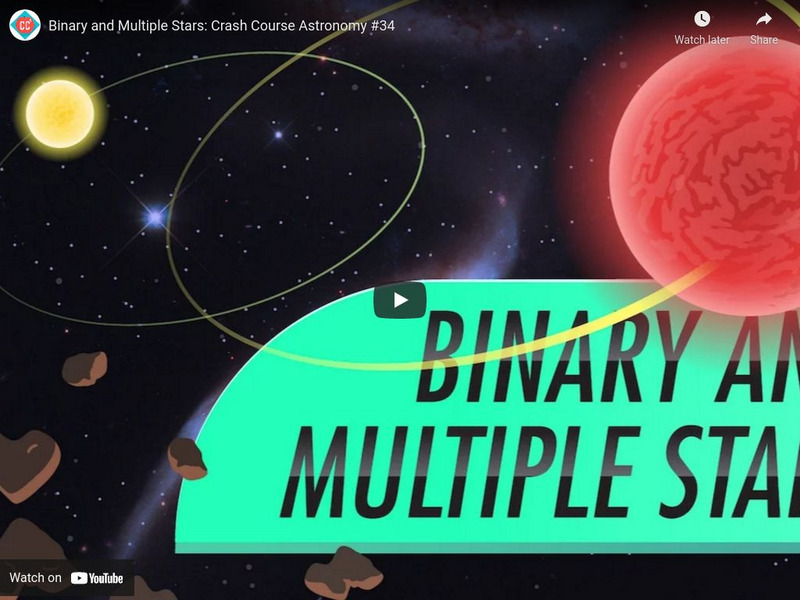Hi, what do you want to do?
Massachusetts Institute of Technology
Mit: Blossoms: The Parallax Activity: Measuring the Distances to Nearby Stars
Determining the position of a star or other object in three-dimensional space is an important concept in astronomy. Finding stellar longitude (called right ascension) and latitude (declination) is easy enough, but it is much harder to...
NASA
Science at Nasa: Science Casts: A Star With Spiral Arms
Using a Japanese telescope, NASA-supported researchers have found the first clear case of a star with spiral arms. [3:36]
PBS
Pbs Learning Media: Crash Course Astronomy: Stars
Phil explains the stars and how they can be categorized using their spectra. Together with distance, a star's spectra provides a wealth of information, including their luminosity, size, and temperature. We also learn about the HR...
PBS
Pbs Learning Media: Crash Course Astronomy: Star Clusters
Last week we covered multiple star systems, but what if we added thousands or even millions of stars to the mix? A star cluster. [10:21]
PBS
Pbs Learning Media: Crash Course Astronomy: Low Mass Stars
Today we are talking about the life-and death-of stars. Low mass stars live a long time, fusing all their hydrogen into helium over a trillion years. More massive stars like the Sun live shorter lives. They fuse hydrogen into helium, and...
PBS
Pbs Learning Media: Crash Course Astronomy: Black Holes
Stellar mass black holes form when a very massive star dies, and its core collapses. Black holes come in different sizes, but for all of them, the escape velocity is greater than the speed of light, so nothing can escape, not matter or...
PBS
Pbs Learning Media: Crash Course Astronomy: Neutron Stars
In the aftermath of an 8-20 solar mass star's demise we find a weird little object known as a neutron star. Neutrons stars are incredibly dense, spin rapidly, and have very strong magnetic fields. Neutrons stars with the strongest...
PBS
Pbs Learning Media: Crash Course Astronomy: Nebulae
Astronomers study a lot of gorgeous things, but nebulae might be the most breathtakingly beautiful of them all. Nebulae are clouds of gas and dust in space. Some nebulae are small and dense, others can be dozens or hundreds of light...
PBS
Pbs Learning Media: Crash Course Astronomy: Binary and Multiple Stars
Double stars are stars that appear to be near each other in the sky, but if they're gravitationally bound together we call them binary stars. Many stars are actually part of binary or multiple systems. In some close binaries matter can...
PBS
Pbs Learning Media: Treasures of the Earth the Origin of Heavy Elements
Learn about the formation of elements from this video by NOVA and how these elements were incorporated into Earth when it formed. Closed caption available. [2:27]
Khan Academy
Khan Academy: Stellar Parallax: Parallax in Observing Stars
Explains the concept of parallax and what it is in the context of nearby stars. [7:21]
Khan Academy
Khan Academy: Stars, Black Holes and Galaxies: Cepheid Variables 1
Describes the impact of Henrietta Swan Leavitt's work on Cepheid variable stars. She discovered a linear relationship between the relative luminosity and the period of these variable stars. This enabled astronomers to estimate how far...
Crash Course
Crash Course Kids 25.2: Star Personalities
In this episode of Crash Course Kids, the hosts chats about the differences among the stars, and tells us what those differences mean. [4:25]
Crash Course
Crash Course Astronomy #28: Brown Dwarfs
While Jupiter is nowhere near massive enough to initiate fusion in its core, there are even more massive objects out there that fall just short of that achievement as well called brown dwarfs. Brown dwarfs, have a mass that places them...
Crash Course
Crash Course Astronomy #35: Star Clusters
There are many different kinds of star clusters, though. Open clusters contain hundreds or thousands of stars held together by gravity. They're young, and evaporate over time, their stars let loose to roam space freely. Globular...
Crash Course
Crash Course Astronomy #29: Low Mass Stars
Today we are talking about the life -- and death -- of stars. Low mass stars live a long time, fusing all their hydrogen into helium over a trillion years. [12:03]
Crash Course
Crash Course Astronomy #26: Stars
Today Phil's explaining the stars and how they can be categorized using their spectra. Together with their distance, this provides a wealth of information about them including their luminosity, size, and temperature. The HR diagram plots...
Crash Course
Crash Course Kids 20.1: Seeing Stars
So you know what a star is, right? Well, if you don't, you should. We've talked about that big one in the sky a few times: The Sun! But there are a lot of bright dots in the night sky and not all of them are stars. Today, let's play a...
Crash Course
Crash Course Astronomy #30 White Dwarfs & Planetary Nebulae
White dwarfs are incredibly hot and dense objects roughly the size of Earth. They also can form planetary nebulae: huge, intricately detailed objects created when the wind blown from the dying stars is lit up by the central white dwarf....
Crash Course
Crash Course Astronomy #34: Binary and Multiple Stars
Stellar mass black holes form when a very massive star dies, and its core collapses. Black holes come in different sizes, but for all of them, the escape velocity is greater than the speed of light, so nothing can escape, not matter or...
Crash Course
Crash Course Astronomy #31: High Mass Stars
Massive stars fuse heavier elements in their cores than lower mass stars. This leads to the creation of heavier elements up to iron. Iron robs critical energy from the core, causing it to collapse. The shock wave, together with a huge...
Crash Course
Crash Course Astronomy #33: Black Holes
Stellar mass black holes form when a very massive star dies, and its core collapses. Black holes come in different sizes, but for all of them, the escape velocity is greater than the speed of light, so nothing can escape, not matter or...
Crash Course
Crash Course Astronomy #32: Neutron Stars
Neutron stars are incredibly dense, spin rapidly, and have very strong magnetic fields. Some of them we see as pulsars, flashing in brightness as they spin. Neutrons stars with the strongest magnetic fields are called magnetars, and are...
Crash Course
Crash Course Astronomy #36: Nebulae
There are many different kinds of star clusters. Open clusters contain hundreds or thousands of stars held together by gravity. They're young, and evaporate over time, their stars let loose to roam space freely. Globular clusters, on the...




















